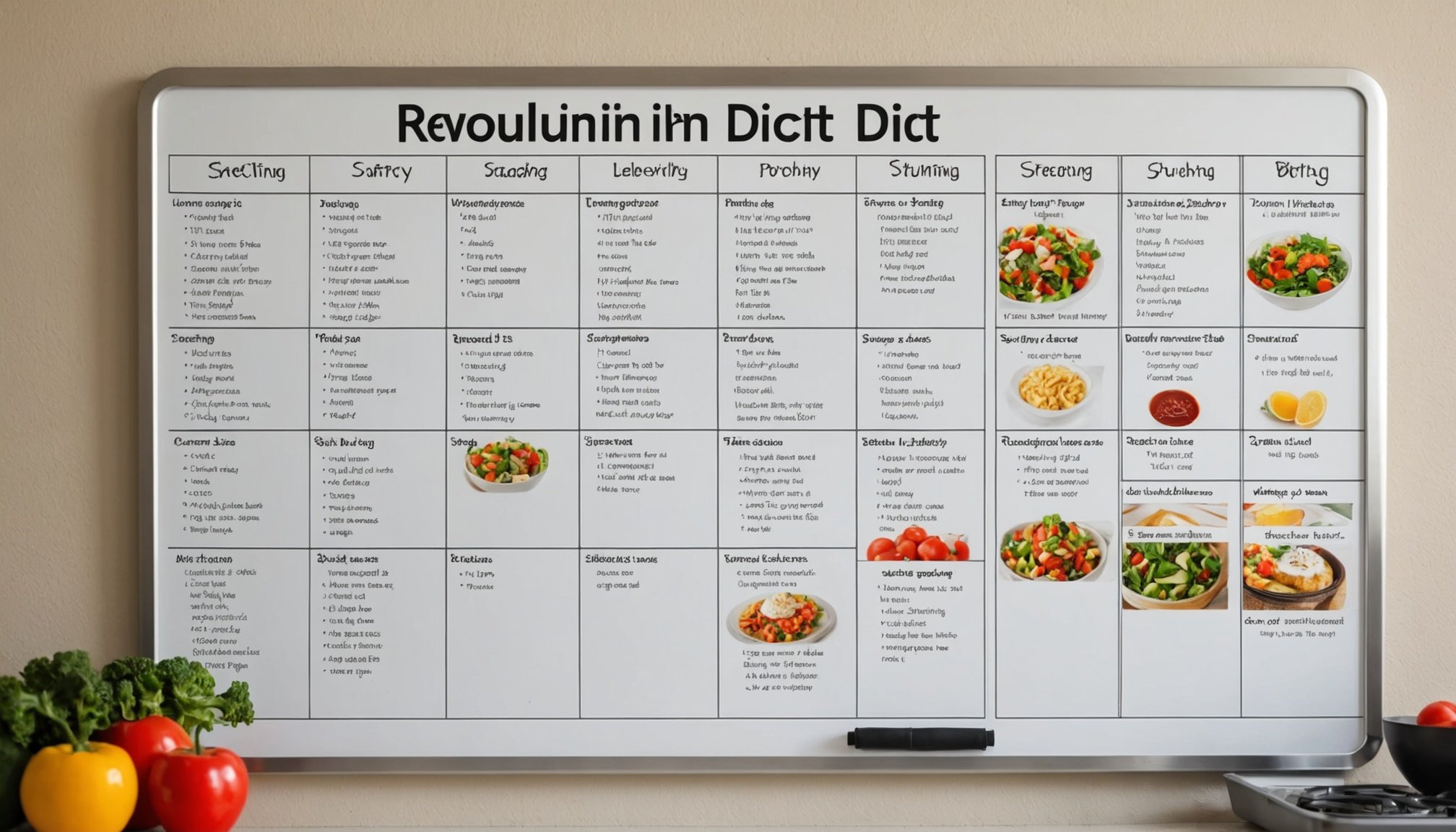Utilizing a Meal Planning Whiteboard for Diet Success
A meal planning whiteboard can be a powerful tool in achieving a slim diet, offering visual benefits that enhance motivation and organization. The ability to see your weekly meals laid out provides clarity and helps maintain focus on diet goals. This method encourages accountability, making it more difficult to stray from planned meals.
Visual meal planning allows for easy adjustments, whether swapping meals or incorporating spontaneous changes. A whiteboard enhances diet tracking by providing a central location to jot down meal components and calorie counts. This promotes a clear overview of the nutritional balance achieved over a week, guiding healthier choices.
Also to see : Revamp Your Diet: How Kitchen Window Placement Shapes Your Mealtime and Nutrition
To creatively use a meal planning whiteboard, consider employing colour codes to distinguish between meal types or dietary needs, such as highlighting high-protein options or low-carb days. Additionally, incorporate fun magnets or stickers to mark completed meals or successful days, keeping the process engaging.
Exploring creative layouts and adding recipe cards or photos of inspiring meals can also be motivational. This approach not only bolsters adherence to a slim diet but transforms the meal planning experience into an enjoyable ritual rather than a chore.
Have you seen this : Revamp Your Kitchen Corner: Create a Mini-Gym Space to Supercharge Your Weight Loss!
Setting Up Your Meal Planning Whiteboard
Creating a meal planning whiteboard setup that enhances your diet success involves key considerations and decisions.
Choosing the Right Location
When positioning your whiteboard, select a spot in the kitchen that is well-lit and highly accessible. This ensures you can easily update your meal plans and track progress. The board should be visible during daily activities, making it a constant reminder of your dietary goals.
Selecting Whiteboard Size and Style
Whiteboard size and style are crucial in kitchen organization. A generous size accommodates detailed plans, while limited space may benefit from a more compact board. Opt for a style that complements your kitchen decor, enhancing the aesthetic while remaining functional.
Essential Tools to Keep Nearby
To maximise the effectiveness of your setup, ensure essential tools are within reach. Stock up on a variety of coloured markers for detailed meal details and coding. Magnets or sticky notes can be used to add flexibility to your plans, allowing for easy modifications. Finally, consider keeping a small notebook nearby for jotting down new meal prep ideas or brainstorming sessions. These essential items promote creativity and make managing your meal planning whiteboard a seamless, organised experience.
Meal Ideas for a Slim Diet
Exploring healthy recipes can give your meal planning a nutritious boost. For breakfast, consider options like a smoothie bowl with spinach, berries, and oats or an avocado toast on whole-grain bread topped with poached egg. These choices provide essential nutrients, setting a healthy tone for the day.
When planning lunch and dinner, think about including balanced meals such as grilled chicken with quinoa and roasted vegetables or a lentil soup paired with a fresh salad. These meals cater to a slim diet by offering low-calorie, nutrient-dense ingredients without compromising on flavor.
Snacks and desserts can still be enjoyable while keeping health goals in mind. Indulge in sliced apples with almond butter or Greek yogurt with honey and nuts for a sweet yet guilt-free treat. By integrating these meal ideas, you maintain variety and interest in your diet.
Using your meal planning whiteboard, jot down these recipes to provide constant inspiration and help organise your weekly plan. Incorporate varied culinary elements to stay motivated and ensure your diet remains exciting and sustainable. This approach keeps your meal planning dynamic and your diet journey successful.
Tips for Tracking Progress
Integrating diet tracking into your routine can significantly enhance your journey toward achieving slim diet goals. Regular monitoring not only provides a reality check on your progress but also helps maintain motivation by bubbling-up achievements.
Begin by setting clear targets on your meal planning whiteboard. This visibility serves as a constant reminder of your objectives. Daily calorie intake tracking is crucial; utilize available space on the whiteboard to tally calories, ensuring each meal remains within desired limits. Recording this information visually provides an opportunity for immediate adjustments, preventing any nutritional imbalances.
Each week, proceed with a reflection session on the board, assessing what worked well and where improvements can be made. This process fosters learning and encourages iterative changes, keeping you aligned with your slim diet goals.
Celebrating milestones, like consistently following meal plans or achieving weight loss targets, is vital. Use colours or markers to mark these on the whiteboard. This visual representation of success motivates continued effort and serves to remind you of your accomplishments, transforming progress monitoring from a chore into a gratifying experience. This method builds confidence and reinforces positive habits throughout your diet journey.
Enhancing Creativity in Meal Planning
Infusing creativity into meal planning can make the process more enjoyable and effective. Utilising creative cooking techniques and seeking culinary inspiration are key to maintaining interest and success in your slim diet journey.
Incorporating Seasonal Ingredients
The use of fresh, seasonal produce not only boosts the nutritional content of meals but also keeps your menu varied and exciting. By adapting your meal planning strategy to include seasonal fruits and vegetables, you can enjoy the best flavours and nutritional benefits. This approach also encourages experimentation with different ingredients, offering endless possibilities for fresh, nutritious meal ideas.
Experimenting with New Cuisines
Bringing international flavours into your kitchen can reignite passion for home-cooked meals. Exploring diverse cuisines can inspire a rotation of unique dishes and keep dietary routines dynamic. Experimenting with global recipes helps expand your culinary repertoire, ensuring that your meal planning remains engaging and far from monotonous.
Themed Meal Planning
Establishing themed days, like Meatless Monday or Taco Tuesday, is another effective way to diversify your meal rotation. This approach stimulates creativity in meal prep and ensures varied meal ideas that prevent diet fatigue. Planning themed meals provides structure while maintaining room for innovative recipes, creating a delightful and sustainable meal planning experience.
Visual Inspiration and Examples
Transforming your meal planning approach with visual aids can spark motivation and efficiency. By showcasing meal planning examples, you can derive new ideas to elevate your organisational skills and diet consistency.
Consider using before-and-after photos to depict the transformation in your kitchen’s organization. These images can serve as a tangible reminder of how structured planning improves both efficiency and dietary outcomes. A well-organised meal planning area naturally aligns with diet success, simplifying the process of sticking to a slim diet.
Additionally, success stories play a crucial role in encouraging determination. Exploring accounts of those who have excelled by using a meal planning whiteboard provides both inspiration and practical strategies. Learning from others’ experiences can drive home the benefits of structured meal preparation and reinforce the idea of sustained commitment.
For practical inspiration, analyse a few effective meal planning layout designs. Ideas such as weekly grids, colour-coded meal types, or motivational quotes can personalise your whiteboard, making it more appealing. Visuals combined with meal planning initiatives lead to a dynamic and inspiring setup that encourages adherence to dietary goals. Engage your creativity to craft a meal planning corner that is both functional and inspirational.

